I have a couple videos coming up on pistols from the trials that eventually led to the adoption of the 1911, so today is a refresher from a couple years back when I posted a copy of the official trials report from the 1907 testing…
When the US began its engagement in the Philippines at the close of the 19th century, the standard service sidearm was a .38 caliber double-action revolver. This was found to be insufficient for serious combat use, and a program was instituted to find a .45 caliber replacement handgun.
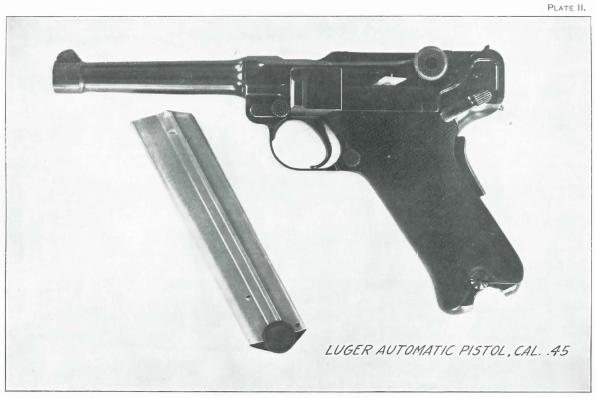
A small group of officers convened in January and March of 1907 to conduct trials on the pistol designs that had been submitted to the Army, including several guns that would become iconic. The automatic pistols tested included the .45-caliber Luger, Colt, Savage, Bergmann, Knoble, and Merill-White. There were also three revolvers present, Colt and Smith & Wesson double actions and a Webley-Fosbery automatic revolver.
The guns were put through firing tests including dust exposure and rusting. And as a side note, I should point out that the took the rust test pretty seriously:
17. Rust. The mechanism will be thoroughly cleansed of grease
by boiling in a solution of soda, the ends of the barrel tightly corked,
and the pistol then placed in a saturated solution of sal-ammoniac
for five minutes.
The Colt and Savage designs performed well, as did both American revolvers. The Luger proved to have reliability issues with commercial ammunition, and the testing commission was concerned that the powder required by Luger was not available in the US. My pet favorite the Bergmann was unfortunately dropped from testing when its hammer mechanism produced consistent light hits and failed to fire. The Knoble was deemed a crude piece of junk and not tested, and the Merill-White was too unreliable to warrant further consideration. The Webley-Fosbery was judged to be unnecessarily complicated without any significant advantages.
The outcome of the tests was twofold. The officers understood that the automatic pistol was clearly going to become the standard sidearm in the future, but they also believed that proper development and selection of an automatic would take several more years. So they recommended that the Army purchase enough Savage and Colt automatics to equip several units and continue testing them. In the meantime, they also recommended replacing the current .38 with the Colt .45 revolver as a stopgap if any significant further combat was anticipated in the Philippines (in a show of frugality not seen by recent government agencies, they noted that the $40,000 expense of such a replacement was only worthwhile if significant further conflict was expected in the short term). The ultimate winner, of course, would prove to be the Colt automatic.
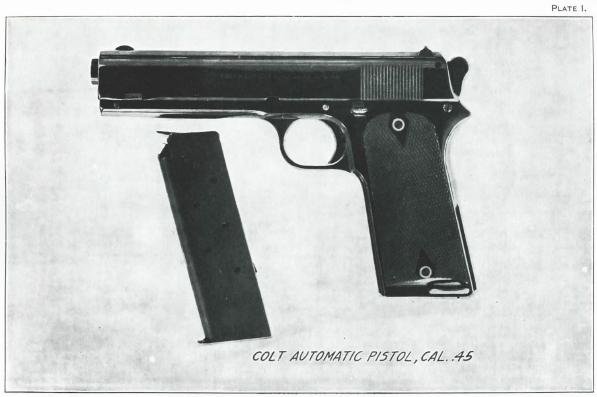 You can download a copy of the trials report (including photos of each gun tested) here:
You can download a copy of the trials report (including photos of each gun tested) here:

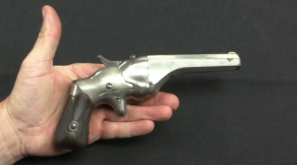
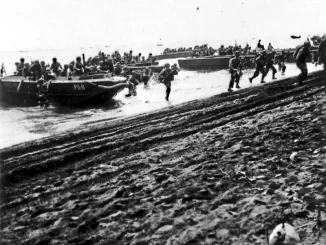
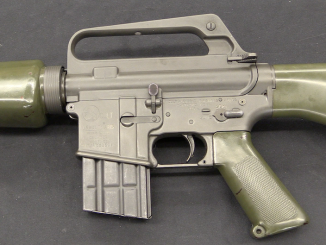
“.45-caliber Luger”
Now Luger pistol is associated with Germany, but firstly it was adopted by Switzerland (as Ordonnanzpistole 1900) firing 7.65x21mm (.30 Luger in US parlance). I’m interesting what say Swiss report which compared Luger to other proposed automatic pistols.
Also it seems that Luger operation principle heavy influenced Oberstbrigadier Adolf Furrer as he used Kniegelenkverschluss in his designs: 24 mm Tankbüchse 41 (self-loading anti-tank rifle), Lmg 25 and even 9x19mm sub-machine gun MP 41/44 (which in fact was dwarf Lmg 25)
Addition: If Kniegelenkverschluss entry in German wikipedia is true, this principle was also used in 34mm Swiss AA gun, the designation of this weapon is not stated, only match I found is 34 mm Flab Kan 38, see photo here:
http://www.militaerfahrzeuge.ch/unterkategorie_26_34_398.html
Notice that this gun was liquid-cooled (hence the jacket around barrel)
The 1900 and 1907 tests were brutal on the weapons. They were done cheaply and produced results that were useful.
I once read about test of self-loading rifles in Imperial Russia. Among others requirements were:
– deliver 10 examples – this prevent should prevent extensive hand-labour weapons
– demonstration firing has to be done by gun designer – to prove that fire-arm is safe to user (i.e. will not throw bolt into shooter face)
“in a show of frugality not seen by recent government agencies”
This was very common before the establishment of the Federal Reserve (private bank) where we are doing everything off of credit.
U.S. Constitution: Article I, Section 8, Clause 12
“The Congress shall have Power To …raise and support Armies, but no Appropriation of Money to that Use shall be for a longer Term than two Years….”
At the turn of the 20th century folks in the U.S.A. still felt well enough isolated from foreign threats to pay attention to this part of the U.S. Constitution.
I’m thinking it wasn’t just an arranged test of the sidearm in a controlled environment; we rode horses back then, and bounced up and down constantly. Why are there so many devices on the 1911 to keep it from discharging? Who needs a grip safety when you are driving a Jeep?
Driving an old army jeep off road was quite the experience. It bounced, hopped, and jumped all over the place. I’d say that riding a horse over the same ground was often the smoother mode of transportation. ^__^
The original Browning automatic design didn’t have many controls. The hammer, trigger, and magazine release were about it. The slide hold-open, thumb safety, and grip safety all came later at the request of the military.
“The original Browning automatic design didn’t have many controls. The hammer, trigger, and magazine release were about it.”
Interesting fact: early Colt 1900 has “sight-safety”:
https://www.forgottenweapons.com/early-automatic-pistols/colt-1900-sight-safety/
however it proved to be awkward to use and hence abandoned
Here’s the original Browning patent:
http://www.google.com/patents/US580924
Note three things: 1. No “sight safety” … 2. Only “safety” is half-cock notch on hammer, (another interesting feature of this patent is this: what we call the “disconnector” on the 1911 is locked in the upper position when the hammer is in half-cock, locking the slide to the frame) … 3. When the hammer is lowered, the firing pin protrudes from the breech face.
Lots of things were done to this original concept to make it more attractive to the military, and drop-safety was a major requirement. When the “sight safety” was removed, an inertial firing pin was added to begin addressing their concerns. More modifications would follow. ^__^
The recommendation to replace the .38 caliber Colt revolvers with .45 caliber ones in the short term, and a .45 caliber automatic pistol in the long term, showed mainly the board’s misunderstanding of ballistics and the changes created by smokeless powder.
The .38 Colt failed as a manstopper not because of its low caliber but due to its lack of velocity. It fired a 150-grain round-nosed lead bullet at 770 F/S for 195 FPE. That’s almost exactly half the energy of the .45 Colt round; 255-grain RNL @ 855 F/S for 405 FPE. No wonder it didn’t put a juramentado Moro on the ground as fast or as decisively as the older .45 round.
The fact that the high-velocity (for its time) .30-40 Krag round (180-gr @ 2470 for 2440) knocked them over even more emphatically than the .45 revolver, or even the .45-70 rifle ( 405-gr. @ 1320 for 1570), doesn’t seem to have impinged on their consciousnesses.
They could have saved the taxpayers a lot of money, and everyone a lot of aggravation, by simply getting the .38 150-grain’s MV up to about 1250-1300 F/S and ME up to about 500-550 FPE. With or without expanding bullets. (Remember, we were not a signatory to the Hague Accord regarding those, albeit due to the provisions regarding “war gases”, not “dum-dum” bullets.)
As to durability, the Colt 1892 and 1894 revolvers evolved into the Army Special aka Official Police. They were medium to heavy-frame revolvers which, given proper heat treatment, should have easily accommodated high-velocity and high-pressure .38 loads.
The same basic revolver was to become the “Three-Fifty-Seven”, “Trooper”, and “Python” in the 1950s, so there should have been no problems on that account.
John Browning maintained that a .38 (.36) caliber bullet was enough to get the job done, if you got it going fast enough, which was what smokeless powder was all about- velocity.
It’s also noteworthy that in the Thompson-LaGarde “bullock” tests, the only “one-shot” stops recorded were hits to the animal’s brain or heart.
With a 7.65mm Parabellum, aka .30 Luger. None of the heavy-caliber rounds had the necessary penetration to get that far inside the animal.
Moral;
1. Only center hits to critical areas count.
2. In “stopping power” as in traffic safety, Speed Kills.
cheers
eon
“The recommendation to replace the .38 caliber Colt revolvers with .45 caliber ones in the short term, and a .45 caliber automatic pistol in the long term, showed mainly the board’s misunderstanding of ballistics and the changes created by smokeless powder.”
Still .45 Auto works. I am not aware of reports stating “.45 Auto lacks stopping power”.
“.30-40 Krag round (180-gr @ 2470 for 2440) knocked them over even more emphatically than the .45 revolver”
Any rifle firing full-power cartridge will be more effective in stopping than revolver chambered for handgun cartridge.
“John Browning maintained that a .38 (.36) caliber bullet was enough to get the job done, if you got it going fast enough, which was what smokeless powder was all about- velocity.”
https://en.wikipedia.org/wiki/Colt_M1900 states that .41 caliber cartridge was tested in Colt 1900 automatic pistol.
Duh… .30-40 Krag doesn’t have as high a muzzle velocity as 7×57 Mauser, but perhaps that doesn’t keep it from really messing up a victim’s innards (bullet tumbling is what really does damage, not just the initial penetration)…
Actually, with equivalent bullet weights, there is almost no difference between the two, according to Barnes;
.30-40 Krag, 180-grain factory load;
2470 F/S, 2440 FPE
7 x 57 Mauser, 175-grain factory load;
2490 F/S, 2410 FPE
The difference wouldn’t pay anyone’s funeral expenses.
All long, narrow bullets tumble in the body cavity. (I’ve looked in a few over the years, not all of them deer.) The Krag bullet, being round-nosed, tumbles with a bit more alacrity than the Mauser’s spire-point due to its different mass distribution. Either one leaves a wound that you really don’t want through your innards.
cheers
eon
The .41 (aka 9.8mm Browning- it was actually closer to a .39 caliber, like the old .41 Colt) was developed precisely because Browning suspected that U.S. Army Ordnance would not accept any “.38 caliber” cartridge. The 9.8mm was the largest cartridge, dimensionally, that the Colt/Browning 1900-type or “Military Model” .38 caliber automatic could accommodate. When it was rejected, he and Colt developed the second, larger-framed Military Model, built around their .45 cartridge. The only thing AO did in creating the .45 cartridge we know today was increase the bullet weight from 200 to 230 grains.
BTW, the reason that DWM was worried about their .45 Parabellum not being able to handle the .45 cartridge in testing was that they had apparently developed it around the earlier 200-grain bullet load’s pressures, etc., and the action was balanced for that, not the later 230-grain being used in the tests.
No, the .45 ACP has never been lacking in “stopping power”. But considering that its ME is almost identical to that of the 9 x 19 and 7.63 x 25, has there ever been an apples-and-apples comparison of the three rounds’ track records in that department?
Of course a full-on rifle round has more power than a pistol round. It also outperforms a lower-powered rifle round, in spite of the lower-powered rifle round being of pistol bore diameter and firing a heavier bullet. The U.S. Army’s reserve units found this out the hard way in Cuba in 1898, with National Guard units still armed with .45-70 “trapdoor” Springfields (no, seriously) up against Spanish units with 7 x 57 Mausers.
cheers
eon
Priceless, Andrzej
Too bad the Knoble was junk. It has a cool “Buck Rogers” feel to it. I would also give the Savage points for aesthetics.